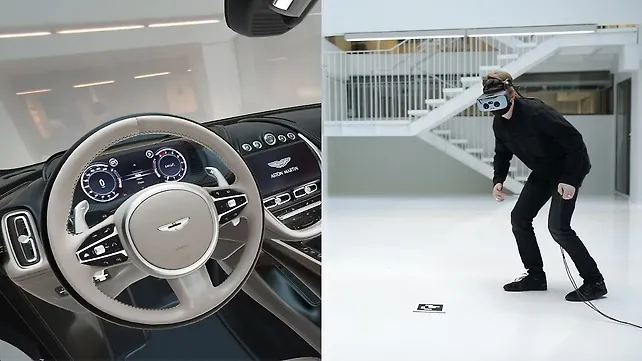
Aston Martin's DBX is the first SUV ever built by the British luxury manufacturer. The newly created ultra-realistic DBX immersive engagement experience developed for customers, designers, and dealers highlight the accelerated adoption of Virtual and Mixed Reality (VR/MR) technologies.
Like other automakers, Aston Martin has been encouraged by dramatic leaps in display hardware and technological advances that sense and integrate the real and synthetic environments. The carmaker first started using VR technologies for its Valkyrie hypercar, which was launched in 2016. At that time, the technology was used to create a customer experience where they could specify the car, choose different colours and trim levels. However, it was the challenge due to the COVID-19 pandemic last year, which convinced Aston Martin to accelerate the adoption of VR/MR technologies.
While the pandemic deeply impacted customer visits to showrooms, the automaker also faced problems with its designers not being able to work as closely as they would have in normal circumstances.
Pete Freedman, Vice President and Chief Marketing Officer at Aston Martin, said, 'We are looking at how Extended RealtyRealityand VR can be used to allow our design teams to collaborate remotely, and still be able to design our next-generation of cars just as effectively as before,'
Aston Martin is now looking to expand the use of these technologies within other areas of the company, such as marketing, design and engineering. Greater adoption of immersive technologies will allow customers to view the cars in a virtual environment and customise and view selected options. Delivering sales training to frontline staff is another area where VR/MR technologies will be at the forefront, as realistic product training can be provided without requiring a physical car onsite. From a design standpoint, the improved graphic capability now available to Aston Martin's design teams will allow them to iterate more quickly, earlier in the process and save costs on developing costly physical models.
DBX a Frontrunner for Immersive Technologies
To deliver the futuristic and immersive visual experience on the DBX, the OEM turned to Lenovo. 'We've worked with a number of VR solutions in the past, but the ProXR solution from Lenovo has really changed the game in terms of graphics and image fidelity. They've made such a big step forward with the ThinkStation P620, equipped with NVIDIA's new RTX A6000 GPU, that they've given us the confidence to start using VR and XR more in front of our customers,' Freedman said.
The hyper-realistic virtual version of the DBX has over 10 million polygons presented in millimetre accuracy through Unity's High Definition Render Pipeline. To deliver a never-before-seen immersive experience of the DBX, Lenovo partnered with Finland based XR/VR headset provider Varjo. The firm's XR-3 headset uses pass-through MR technology to allow real-time reflections and shadows in demonstrations, making the real world and the virtual Aston Martin DBX blend seamlessly together.
'The challenge is to recreate reality with visual parity, blending the virtual and the real seamlessly together. The ultimate goal is to get the emotional response to match the feeling of stepping into a brand new physical car with a digital twin. This is the challenge where Varjo is working side-by-side with automotive designers and engineers around the world. We are happy that our human-eye resolution visual fidelity and photorealistic mixed reality are seen as unmatched by any other technology or product currently out there,' Jussi Mäkinen, Chief Brand Officer at Varjo said in an email to Mobility Outlook. The Nordic firm is already working with almost all of the world's leading car manufacturers. 'We help them to solve the most complex and creative design challenges from enabling virtual collaboration between European and Asian design studios to enabling testing virtual interiors and advanced safety features in real-time while driving the car,' Mäkinen said.
VR Headset 101
Commonly known VR headsets today are Microsoft's Hololens or those from Oculus. Varjo's XR-3 headset, however, is an entirely different product than Oculus or Hololens. The Varjo XR-3 was created for the most demanding professional use, with industry-leading human-eye resolution visual fidelity (over 70 pixels per degree) in VR and MR; it greatly differs from Oculus. While Oculus is a great VR product for consumers and gamers, it is not fitting for automotive design professionals looking to enhance their 3D workflows. Microsoft's Hololens, on the other hand, is made for professionals and offers Augmented Reality (AR) capabilities, but as an optical see-through device. The visual fidelity is not photorealistic in Hololens, and it only provides a very limited field-of-view for AR content. While this works for assembly line workers for information overlay purposes, it does not provide the visual fidelity and effectiveness needed by design or simulation professionals.
Decoding VR, AR, MR and XR
It can be quite confusing to decode the alphabet soup that denotes different kinds of synthetic environments. A handy guide is below.
Virtual Reality (VR)
In a VR environment, the user interacts with a completely simulated environment from a viewer-centric perspective and has no interaction with the real world.
Augmented Reality (AR)
Users can interact with both the real world and digital elements in an AR environment. Here digitally-created content is overlayed on top of the real world.
Mixed Reality (MR)
Here highly realistic and believable digitally created virtual objects seamlessly blend into a real-world environment. In an MR environment, one can also interact with virtual objects.
Extended Reality (XR)
VR, AR and MR together are known as XR. In the XR world, physical objects can be placed in the digital world and vice-versa.
All images courtesy: Varjo.